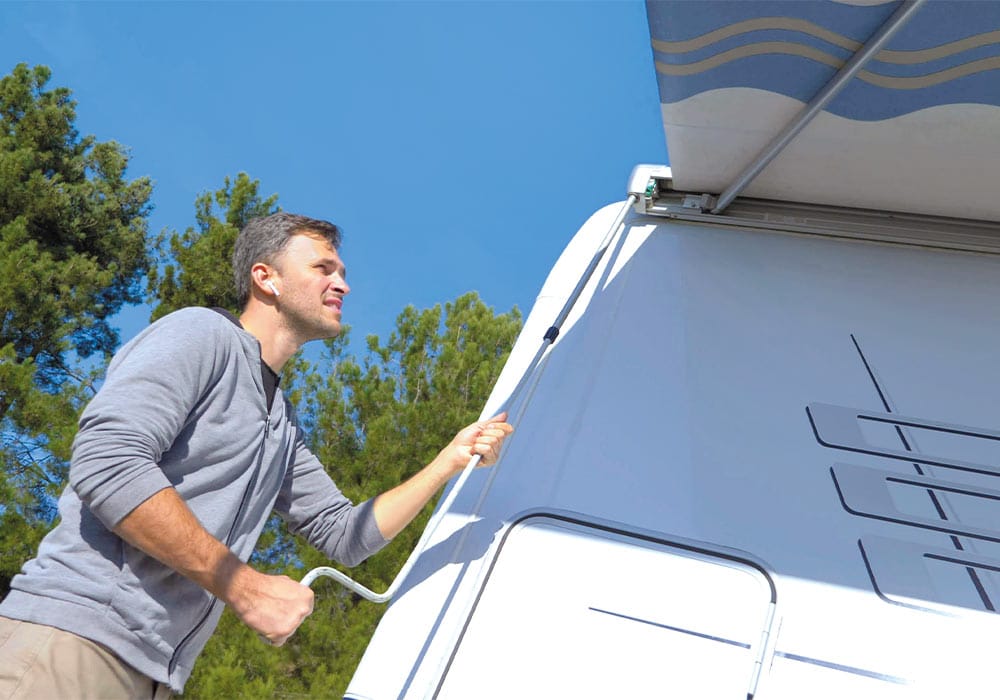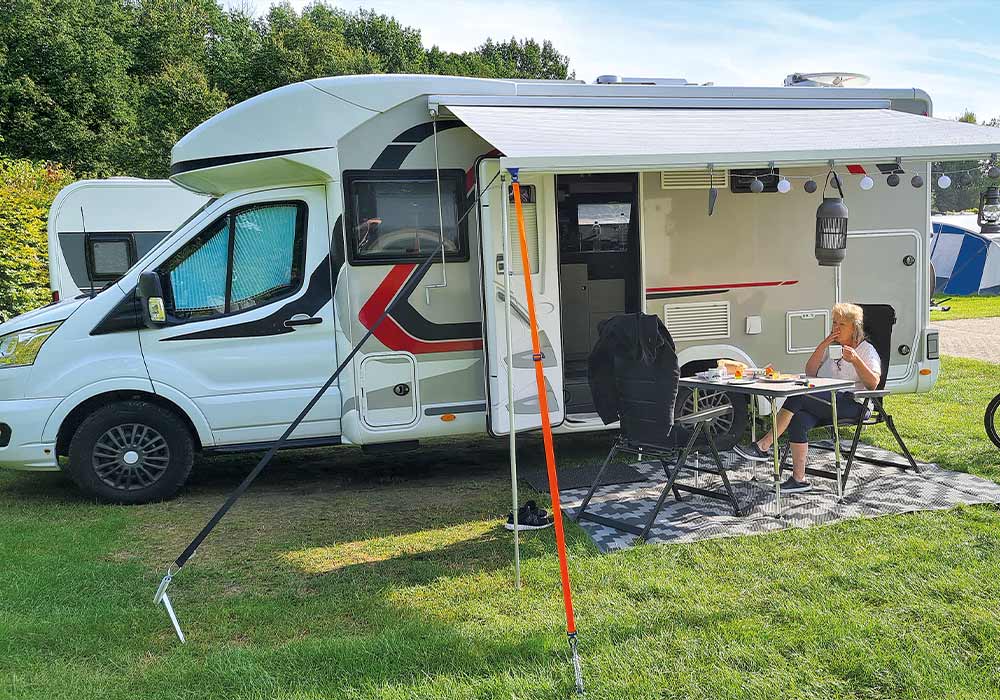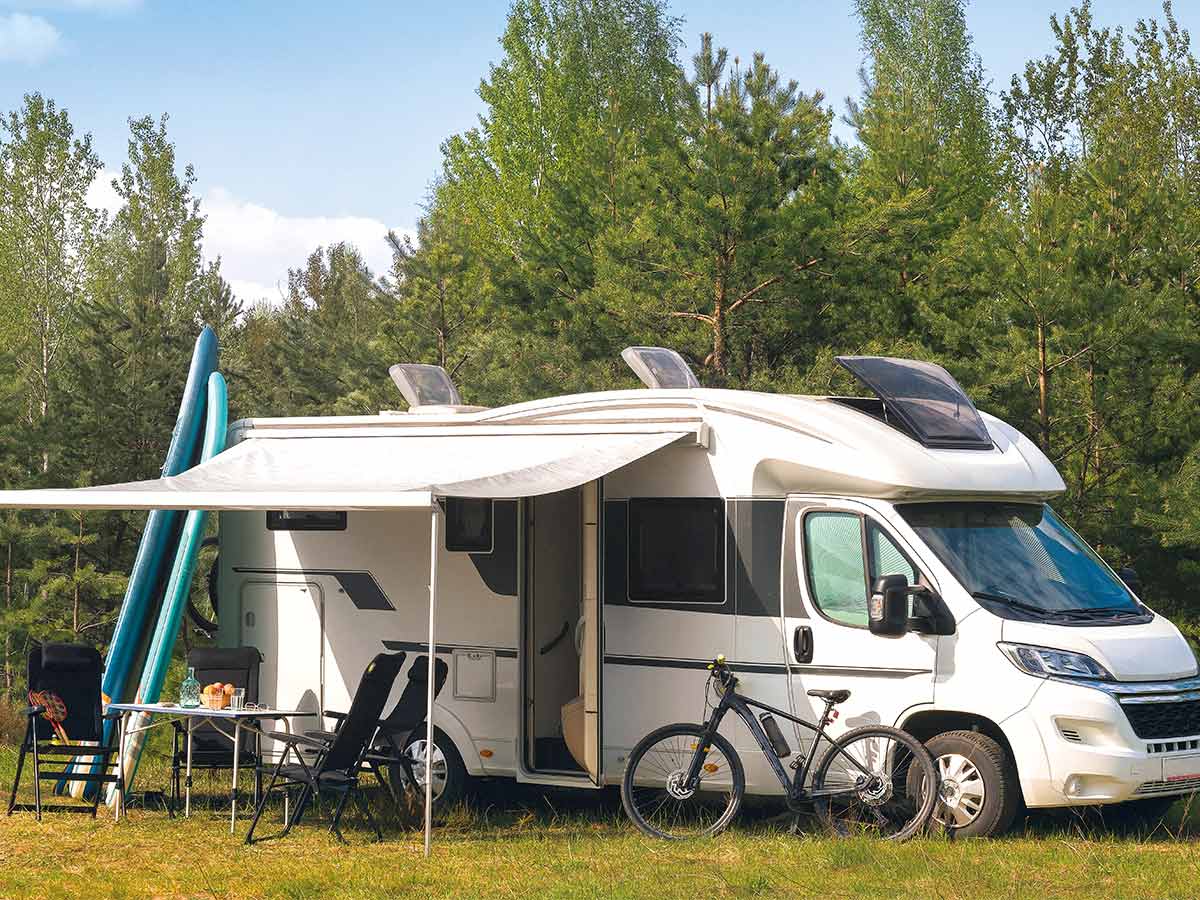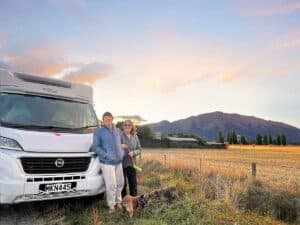A motorhome or caravan is one of the best ways to travel around New Zealand. However, they do have one downside: limited space. Even for those who like it cosy, an RV can feel cramped at times – especially when you have visitors or enjoy activities that require a bit of space. As such, it’s no surprise that many RV-travellers look to expand their space with an awning.
A reliable and suitable awning for your RV can be a game-changer. From providing shade during sunny afternoons and cover from rain to creating additional living and storage space, awnings can significantly enhance life on the road. Yet, with so many options available, choosing the right type can be challenging. In this issue of Getting into Gear, we delve into the different types of awnings and what you need to consider before making a decision.
Wind-out awnings
Wind out awnings are among the most common and convenient options for RV owners. These awnings are stored in a metal case mounted to the side of the motorhome or caravan and can be extended either manually using a hand crank or automatically with an electric motor. Once extended, fold-out legs provide support and can be staked into the ground for additional stability. One of the main benefits of wind out awnings is how simple and quick they are to set up. Within minutes, you can have a shaded area to escape the sun. They are relatively cost-effective, making them an excellent choice for budget-conscious travellers.
However, there are some drawbacks. Wind out awnings offer minimal protection from rain and wind because they lack side walls. Although some models come with the option of attaching side panels, doing so significantly increases the setup and pack-down time. Additionally, wind out awnings are vulnerable in moderate-to-strong winds, which means they must be rolled in to avoid damage. Furthermore, without side coverage, these awnings do not offer any privacy.
Bag awnings

Bag awnings are a more economical alternative, similar to wind-out models but stored in a fabric bag rather than a metal casing. They are bolted to the camper and manually rolled out by unzipping the bag and setting up the lightweight aluminium frame. The material used is typically a thin canvas or polyester, which makes them lightweight and easy to handle. Bag awnings are extremely light and easy to install, often requiring just a couple of brackets. Like wind-out awnings, bag awnings are excellent for creating shade.
However, they come with their own set of challenges. Bag awnings can be tricky to set up alone. In addition, they share the same limitations as wind out awnings, such as sensitivity to wind, lack of privacy, and limited rain protection.
Pole awnings/privacy rooms
Pole awnings, also known as privacy rooms, provide a more substantial and enclosed shelter, effectively creating an additional room attached to the RV. The awning is supported by poles and anchored to the ground. These structures can significantly increase your covered living area, making them ideal for extended stays. When erected properly, pole awnings are wind and weatherproof. The flexibility of packing the components into multiple smaller bags is useful, as the bags can be stored separately, freeing up space.
Nevertheless, pole awnings can be labour-intensive and time-consuming to set up, requiring at least two people. The poles and canvas material can be bulky and heavy, taking up considerable space when not in use. Additionally, since these awnings are attached to the RV, they must be packed down before the vehicle can be moved, which can be inconvenient for those who like to keep moving.
Inflatable awnings

Inflatable room awnings have become increasingly popular in recent years as a modern alternative to traditional pole awnings. These awnings use air-filled struts instead of metal poles, making setup simpler and quicker. They attach to the RV in much the same way as pole awnings and are especially appealing for those who want a large, weatherproof space. The lack of metal poles reduces the complexity of assembly. Once the awning is attacked to the RV via the awning rail, it gets inflated – either by hand or with an electric pump. As a result, with a bit of practice, inflatable awnings can be erected by one person. These structures are usually well-sealed against wind and rain, making them a practical choice for various weather conditions.
However, inflatable awnings do come with a few challenges. They tend to be heavier than other types due to the extra material and all-in-one design, which can make pulling them through the awning rail difficult. Setting them up on uneven ground can also be problematic, as they lack the flexibility of pole-based systems. Packing down inflatable awnings can be time-consuming, as ensuring all the air is expelled to achieve a compact fold requires some effort. Additionally, these awnings come in one large bag, which can be hard to store. Dependence on an air pump is another consideration; if the pump fails or gets lost, setting up the awning becomes a significant challenge.
Tent and tailgate awnings
There are also tent awnings and tailgate awnings, which serve more niche needs. Tent awnings are similar to privacy rooms but are designed for smaller campers or even cars. They attach to the side or rear of the vehicle, creating a tent-like enclosure that provides shelter and extra space. Tailgate awnings, on the other hand, are designed to be attached to the rear of the vehicle, rather than the side. These are ideal for smaller campers and vans with a rear door that opens upwards, offering a simple yet effective way to extend the living area.
Tips and considerations for choosing your awning

Selecting the right awning isn’t just about personal preference; it’s also about practicality. Here are some tips to help you make the right decision:
Vehicle Compatibility: Not all awnings fit every type of RV. Always double-check that your choice matches your vehicle’s fixtures and dimensions.
Weight Matters: Larger awnings add significant weight, which can affect your overall load. Ensure you remain within legal weight limits, especially when fully packed for a trip.
Check for Completeness: If buying a second-hand awning or acquiring one with a pre-owned RV, verify that all parts are present. A missing pole or bracket can render the awning useless.
Wind Management: Awnings, particularly wind-out types, are sensitive to gusts. Always retract your awning if you plan to leave your RV for an extended period, as wind can cause serious damage. For room and tent awnings, a storm strap can provide essential stability.
Ease of Use: Consider whether you can realistically manage the setup. Pole awnings, in particular, may require physical strength and coordination, so practising beforehand can be helpful.
Quality vs. Cost: While it’s tempting to go for the cheapest option, remember that quality can vary widely. Investing in a reliable, durable awning can save you headaches and expenses down the line.
Ultimately, whether you’re after a simple sunshade or a full-fledged outdoor room, there’s an awning to suit your needs and travel style. By carefully weighing the pros and cons of each type and considering your specific requirements, you can make an informed decision and get the most out of your adventures. Enjoy the beauty of New Zealand, knowing you’ve got the perfect cover for your explorations.






